Amazon Simple Email Service (SES)
1. Introduction
Amazon SES is a cloud‐based email platform designed to help businesses and developers send and receive email using their own verified email addresses and domains. It is built on the same highly scalable, reliable, and cost‑effective infrastructure used by Amazon.com, so you can focus on engaging your customers rather than managing email servers.
2. Key Features
Amazon SES empowers you to send both bulk and individual emails in a secure, reliable way. Whether you need to distribute transactional messages like password resets or marketing campaigns to thousands of users, the service scales seamlessly.
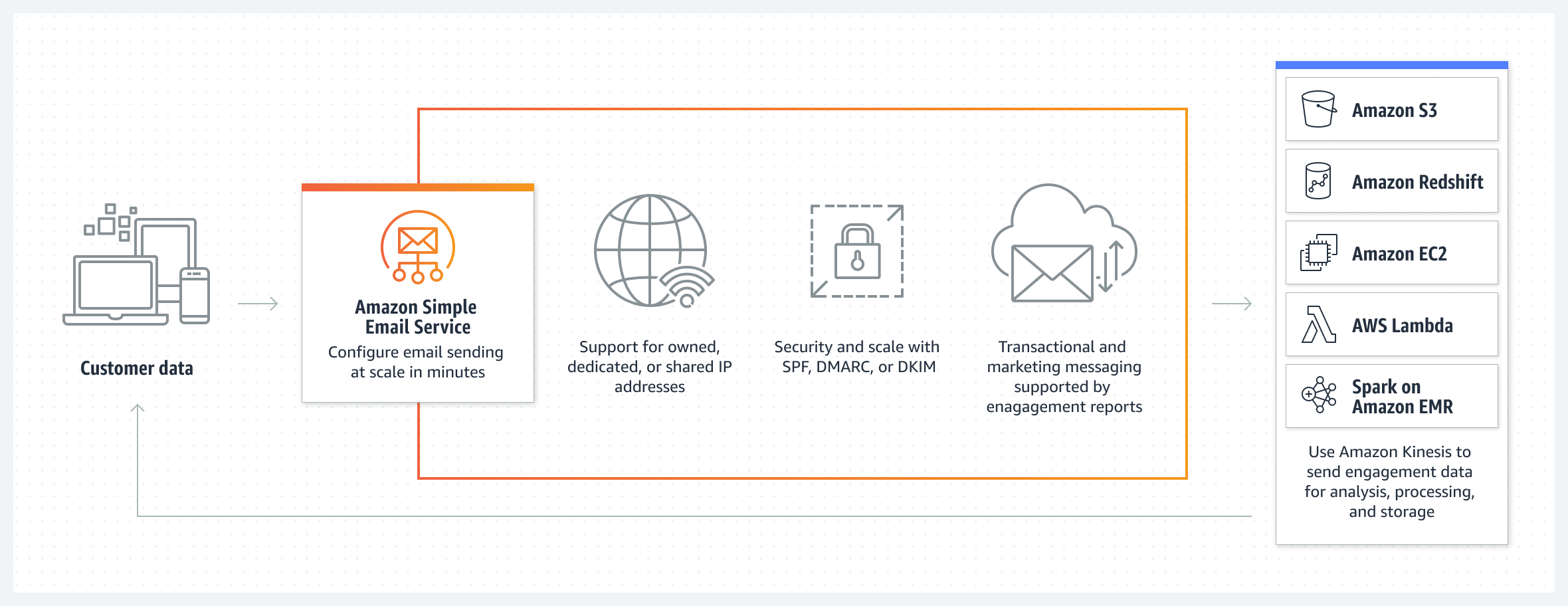
-
Cost‑Effective & Scalable:
You pay based on the volume of emails sent and received with no upfront fees. The service automatically scales to meet high-volume demands, and EC2 users even benefit from a free tier of up to 2,000 emails per day. -
Flexible Sending Options:
You can send email using the AWS Management Console for testing, the SMTP interface for integration with legacy systems or custom software, or directly via the Amazon SES API (with both API v1 and the newer API v2 available). -
Email Receiving & Processing:
In addition to sending, Amazon SES allows you to receive email. With configurable receipt rules and IP address filters, you can process inbound mail (such as routing messages to an S3 bucket, SNS topic, or Lambda function) and build advanced email handling workflows. -
High Deliverability & Authentication:
Amazon SES supports industry-standard authentication methods such as SPF, DKIM (including Easy DKIM via Route 53), and DMARC. These features help ensure that your email reaches your recipients’ inboxes rather than being flagged as spam. -
Monitoring & Reporting:
With integrated tools like CloudWatch, CloudTrail, and detailed API operations (e.g., GetSendStatistics), you can monitor your sending activity, track bounces and complaints, and adjust your email strategies accordingly.
3. Bulk Email and Transactional Email
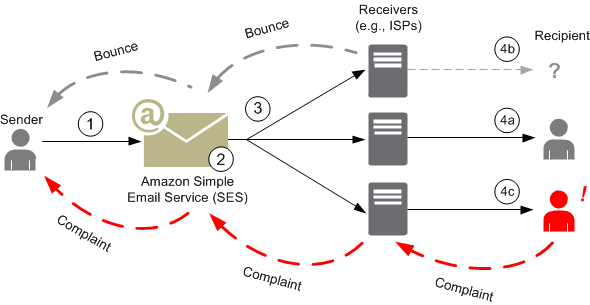
- High-Volume Sending: Built-in scaling ensures you can send large volumes of emails without extensive infrastructure management.
- Delivery Analytics: Track deliveries, opens, bounces, and complaints to refine how and when you engage your audience.
4. IP Address Management
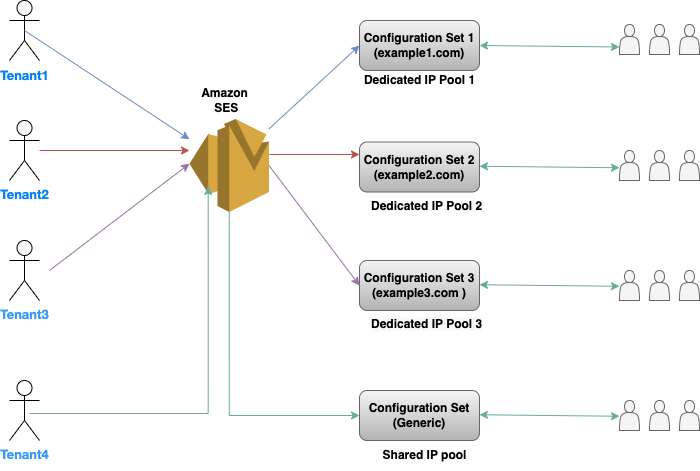
- Shared IPs: Perfect for smaller workloads or those starting out, where you share sending IP addresses with other SES customers.
- Dedicated IPs: Ideal for high-volume scenarios where you want tight control over your sender reputation.
- Customer-Owned IPs: If you already have a pool of trusted IP addresses, SES can integrate them so you maintain complete control.
Exam Tip: If your organization handles both critical transactional emails (like password resets) and promotional campaigns, consider using separate IP pools and configuration sets. This strategy prevents marketing-related bounces or complaints from negatively impacting your transactional email reputation.
5. Reputation Dashboard
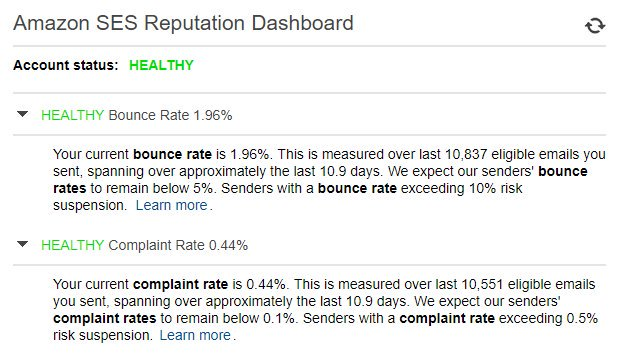
Monitoring how your emails are received by the inbox providers is crucial. The built-in reputation dashboard:
- Displays bounce and complaint metrics.
- Identifies potential deliverability issues.
- Encourages best practices to safeguard your sender reputation.
6. Configuration Sets and Event Destinations
Configuration sets in SES provide a way to group and track the metrics for specific categories of emails. This is particularly useful for:
- Deliverability Analysis: Gain insights on whether emails were opened, bounced, or reported as spam.
- Multi-Channel Notifications: Route bounce and complaint events to external services for further processing.
Within a configuration set, you define one or more event destinations:
-
Amazon Kinesis Data Firehose
Captures email metrics in near real time, allowing you to:- Stream data directly to Amazon S3, Amazon Redshift, or Amazon OpenSearch Service.
- Use services like Amazon Kinesis Data Analytics to visualize click-through and open metrics as they happen.
-
Amazon SNS
Provides immediate notifications about bounces and complaints. This quick feedback loop can trigger automated workflows—such as unsubscribing a user or adjusting marketing campaigns.
Additionally, configuration sets support IP Pool Management, enabling you to isolate transactional messages from marketing or bulk emails. This separation helps you maintain distinct reputations for different use cases.
7. Typical Architecture and Data Flow
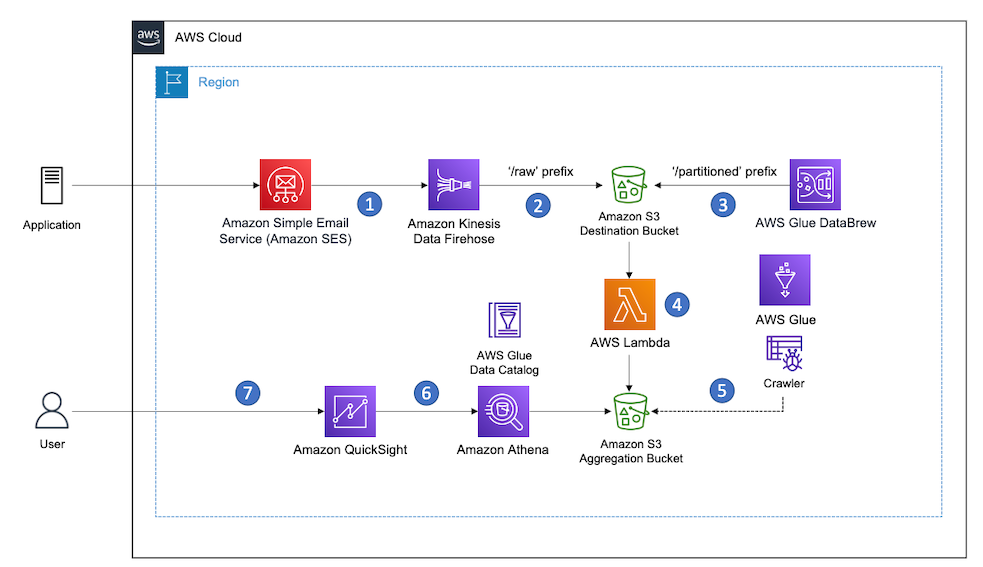
- Amazon SES publishes email sending events to Amazon Kinesis Data Firehose using a default configuration set.
- Amazon Kinesis Data Firehose Delivery Stream stores event data in an Amazon Simple Storage Service (Amazon S3) bucket, known as the Destination bucket.
- AWS Glue DataBrew processes and transforms event data in the Destination bucket. It applies the transformations defined in a recipe to the source dataset and stores the output using a different prefix (‘/partitioned’) within the same bucket. Output objects are stored in the Apache Parquet format and partitioned.
- An AWS Lambda function copies the resulting output objects to the Aggregation bucket. The Lambda function is invoked asynchronously via Amazon S3 event notifications when objects are created in the Destination bucket.
- An AWS Glue crawler runs periodically over the event data stored in the Aggregation bucket to determine its schema and update the table partitions in the AWS Glue Data Catalog.
- Amazon Athena queries the event data table registered in the AWS Glue Data Catalog using standard SQL.
- Amazon QuickSight dashboards allow visualizing event data in an interactive way via its integration with Amazon Athena data sources.
Source: Tracking email engagement with AWS Analytics services
7. Conclusion
Amazon SES delivers a robust platform to manage high-volume email operations, offering thorough metrics and flexible integration points. By leveraging configuration sets, event destinations, and IP pool management, you can optimize email deliverability, gather actionable insights, and maintain separate reputations for different message types.
For further details, consult these official AWS resources: